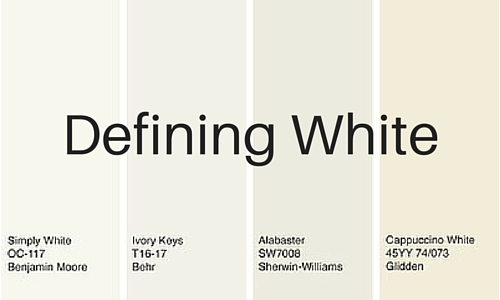Defining White
 Now that we’re past the Christmas holiday season, retailers remind us that January is the month of great shopping deals and white sales. According to Consumer Reports, the best time to buy bedding and linens is in January, and hence the term “white sales”. At the start of the New Year, we think about new beginnings, wiping the slate clean, and starting a-fresh in our lives and in our living spaces. White is a natural tie-in with the New Year.
Now that we’re past the Christmas holiday season, retailers remind us that January is the month of great shopping deals and white sales. According to Consumer Reports, the best time to buy bedding and linens is in January, and hence the term “white sales”. At the start of the New Year, we think about new beginnings, wiping the slate clean, and starting a-fresh in our lives and in our living spaces. White is a natural tie-in with the New Year.
“White” can mean many different things – white paint, white house, white noise, white collar, white label, white chocolate, whiteout, white flag, pearly whites, white knight, and white lightning, just to name a few.
When we think of the word “white”, we usually think of the color white, a pure color that contrasts with and compliments just about every other color. It is a good choice if you are looking to start over and freshen up your living space for the New Year. White is clean and bright and adds a feeling of openness to spaces.
White is probably the most common color used for building trim and wall color, especially in modern spaces. We like white because it emphasizes form and produces crisp shadows that compliment architecture. In contrast, black and dark colors produce a silhouette effect which can also be really effective.
Although white is sometimes perceived as the absence of color, the science of color teaches us that white is not really colorless at all. In fact, white is the presence of all the colors of the spectrum.
Our perception of “white” depends a lot on the material to which it is applied. For example, a rough wood barn beam will have limited light reflectance as compared to a plastic laminate countertop. Each material will respond best to a different white hue (color) and level of saturation (intensity).
Adjacent materials may also impact our perception of the color white, especially if the adjacent color is bright. White can be a chameleon and the effect can be quite striking. When white is next to bold colors like red, the white may appear pink.
Fortunately, there are a multitude of shades of white to choose from for every space and material. Paint and materials manufacturers may describe various shades of white as the items they imitate, such as lace, ivory, chalk, snow, shell, milk, and lily. Some whites are bright and sterile while others are warm and muted. White is often associated with positive things like purity, cleanliness, light, innocence, and goodness. Perhaps this is why white is such a popular color.
Start out the New Year afresh – try adding white to your living space!
For more information on color theory, check out ArtSpeak and ColorMatters.
For white paint ideas, check out Sherwin Williams and Benjamin Moore.



